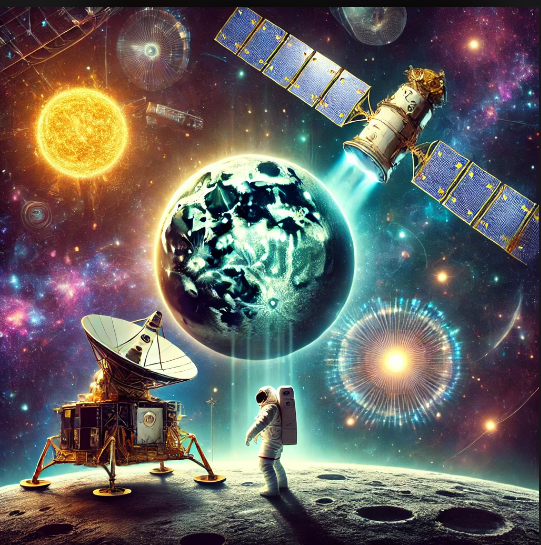Introduction
India’s space program, spearheaded by the Indian Space Research Organisation (ISRO), has made remarkable strides in recent years. With groundbreaking missions like Chandrayaan-3, the upcoming human spaceflight program Gaganyaan, and the solar observation mission Aditya-L1, India has solidified its position as a formidable player in space exploration. These missions exemplify India’s technological prowess and its commitment to scientific discovery and innovation. This article delves into the achievements of these missions and explores the future objectives of ISRO.
Chandrayaan-3: Achievements and Impact
Overview of Chandrayaan-3
Chandrayaan-3, India’s third lunar exploration mission, was launched on July 14, 2023, and successfully landed on the Moon’s south pole on August 23, 2023. The mission was designed as a follow-up to Chandrayaan-2, aiming to demonstrate safe lunar landing and rover operations.
Key Achievements
- Historic Soft Landing: Chandrayaan-3 became the first mission to land near the Moon’s south pole, a region previously unexplored.
- Pragyan Rover Exploration: The Pragyan rover successfully traversed the lunar surface, analyzing soil composition and detecting key elements such as sulfur.
- Vikram Lander’s Extended Operations: The lander conducted multiple scientific experiments, including temperature profiling and seismic activity analysis.
- Technological Milestones: The mission validated autonomous landing technologies, paving the way for future interplanetary missions.
Scientific Contributions
- Elemental Analysis: Confirmation of sulfur and other elements in the lunar soil.
- Lunar Environment Study: Temperature variations at different depths were recorded for better understanding of the Moon’s thermal properties.
- Seismic Activity: Data gathered on Moon’s seismic movements provides insight into its geological structure.
- Water Ice Detection: The possibility of water ice near the Moon’s south pole is under analysis, which could be crucial for future lunar habitats.
Future Lunar Missions
- Chandrayaan-4: Planned for late 2025, Chandrayaan-4 will focus on resource utilization and advanced lunar surface studies.
- Lunar Sample Return Mission: India is considering a mission to retrieve samples from the Moon and bring them back to Earth for analysis.
Gaganyaan: India’s First Human Spaceflight Mission
Overview of Gaganyaan
Gaganyaan is India’s ambitious manned spaceflight program aiming to send a crew of astronauts into low-Earth orbit (LEO). The mission, initially planned for 2024, will carry a three-member crew aboard an indigenous spacecraft.
Mission Objectives
- Demonstrate Human Spaceflight Capability: The mission will test critical life support, environmental control, and crew safety technologies.
- Enhance India’s Space Exploration Potential: Establishing a human spaceflight program will strengthen India’s long-term interplanetary ambitions.
- Boost Research and Development: The program will drive advancements in space medicine, microgravity research, and space habitation.
- Collaboration with Global Space Agencies: India is in discussions with NASA and Roscosmos for knowledge exchange on human spaceflight technologies.
Technological Developments
- Gaganyaan Crew Module: Designed for re-entry and safe landing with heat shield protection.
- Human-Rated Launch Vehicle (HLV): The GSLV Mk III, modified for crewed missions, will serve as the launch vehicle.
- Space Suit Development: ISRO-developed suits will ensure astronaut safety in microgravity conditions.
- Crew Escape System (CES): Safety protocols include an escape mechanism in case of launch failure.
- Orbital Module: The spacecraft will feature a modular design for flexibility in future spaceflight missions.
Future Prospects
- Space Station Development: Following Gaganyaan, India plans to develop an indigenous space station by 2035.
- Deep-Space Human Missions: Long-term goals include sending astronauts to the Moon and eventually Mars.
- International Partnerships: ISRO is collaborating with space agencies for joint manned missions and research projects.
- Astronaut Training Expansion: India aims to establish its own astronaut training center to reduce reliance on foreign facilities.
Aditya-L1: India’s First Solar Observatory Mission
Overview of Aditya-L1
Aditya-L1, India’s first solar observation mission, was launched on September 2, 2023. The spacecraft is positioned at the Lagrange Point 1 (L1), around 1.5 million km from Earth, allowing uninterrupted observation of the Sun.
Mission Objectives
- Study Solar Corona: Investigate solar corona heating mechanisms and magnetic field dynamics.
- Observe Solar Activity: Monitor solar flares, coronal mass ejections (CMEs), and their impact on Earth.
- Analyze Solar Wind and Particles: Understand how solar wind influences space weather.
- Enhance Space Weather Prediction: Improve forecasting models for solar storms affecting satellite and communication systems.
Future Solar Missions
- Aditya-L2: ISRO is planning an advanced solar observatory with improved imaging and spectroscopic instruments.
- Heliospheric Missions: Future missions may study the heliosphere and its interaction with interstellar space.
Future Goals of India’s Space Program
1. Lunar and Planetary Exploration
- Venus Mission (Shukrayaan-1): Planned for 2025, this mission will study Venus’ atmosphere and climate.
- Mars Orbiter Mission 2 (MOM-2): A follow-up to Mangalyaan, aimed at deeper Martian exploration.
- Asteroid Missions: Plans are underway for asteroid flyby and sample return missions.
- Exoplanet Exploration: Research is ongoing for a mission to study exoplanets and their atmospheres.
2. Technological Innovations
- Reusable Launch Vehicles (RLV): ISRO is developing reusable rockets to reduce launch costs.
- Satellite Constellations: Expanding India’s remote sensing and communication satellites for global coverage.
- Quantum Communication: ISRO is investing in quantum encryption technologies for secure communication networks.
Conclusion
India’s space missions—Chandrayaan-3, Gaganyaan, and Aditya-L1—demonstrate the country’s rapid advancements in space technology and scientific exploration. These missions not only contribute to India’s self-reliance but also strengthen its position in the global space community. With ambitious future goals, ISRO continues to push the boundaries of space exploration, paving the way for new discoveries, technological innovations, and international collaborations. As India advances towards interplanetary exploration, a space station, and human spaceflight, its space program is set to inspire the next generation of scientists and engineers, solidifying its role as a key player in global space endeavors.




